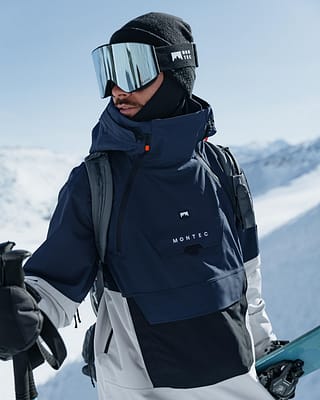Guide to ski goggle lens colors
Looking to set yourself up with new goggles? We know that making the choice can be daunting! With different lens colors and categories, choosing the right design can feel like a high-pressure decision. But don’t worry. We make things a breeze with our easy-on-the-eyes ski goggle lens color guide.

Whether you’re looking to grab your first pair of goggles or secure yourself an upgrade, knowing your VLTs from your ABCs is just good practice. Not all lenses work for all conditions, though. So if you want to get the most out of your riding, it’s best to know what you need for the situation. After all, nothing ruins a whiteout like shredding in a black lens and consequently eating snow every ten seconds, right? Just remember, these are broad strokes – every brand has its own spin on which colors and VLTs are best for different conditions.
With that in mind, lock in your lens this winter with our quick-fire guide! Oh, and talking about locking in…Have you locked in the rest of your gear for the coming season? Check out MONTEC’s newest styles!
How to choose the right ski goggle lens
Understanding VLT (Visible Light Transmission)
The best lens colors for sunny days
The right lens for sun and clouds
The best colors for cloudy days
The ideal choice for night skiing
FAQs
Understanding VLT (Visible Light Transmission)

When it comes to ski goggles, color doesn’t solely dictate how ‘dark’ a lens is. Instead, this is measured as VLT, or ‘Visible Light Transmission’, and is represented by a percentage figure. In short, the higher the VLT percentage, the more light passes through the lens, which means better vision in low light but less glare protection. On the flip side, a lower VLT lets less light in, so it’s perfect for bluebird days when the sun is bouncing off every snowy surface.
As a rule of thumb, the following guidelines apply:
- Lenses with a VLT of less than 20% work best in sunny, high-glare conditions
- Mid-range lenses, around 20-40%, are versatile for mixed weather
- Anything above 40% is ideal for flat light, overcast days, or even night skiing
However, the tricky part is that colors don’t always line up the same way between brands. So, while color gives a general idea, checking the VLT rating for whatever color you’re looking at is the best way to know what you’re getting!
The best lens colors for sunny days
On those perfect bluebird days when the snow is reflecting light like a mirror, you’ll want a lens with a low VLT. Anything under 20% is ideal here, since this VLT rating cuts down on glare and helps prevent eye strain.
Darker tints such as black, grey, green, or blue are common choices for low VLTs that protect your eyes in harsh sunlight. Some brands also offer mirrored finishes for extra glare protection. This added shield is especially handy at high altitudes where the sun is even brighter. But beware that if you go too low and encounter a mix of sun and cloud, things could become too dark. So, a top all-rounder for bright conditions is somewhere around 15-20% VLT range.
The right lens for sun and clouds

Sometimes the weather just won’t play ball. If you’re out riding and its a mix of sun and cloud or even snow and sun, then you’re not going to want to stop every five minutes to swap your lenses. In these situations, it’s always handy to have an ‘all-rounder’ lens to turn to. Something that’s good for both brighter and flatter conditions.
Many brands offer a middle-of-the-road option with a VLT between 20-30%, usually with contrast boosting tech, to ensure that you’re protected from harsh sun, but can also see clearly when the light dips. We think the magic number is around 25%, and generally allows you to ride with one lens and one lens only in most situations! Except for white-outs, that is.
The best colors for cloudy days
On those cloudy days where the light is flat, it’s time to swap to a lens with a higher VLT rating. Anything around 30% to 50% and above will help brighten up your vision. That’s because this rating lets more light in under cloud so you can pick out bumps and changes in terrain.
Colors like yellow, rose, or light red are classic choices for these conditions, as they boost contrast and make it easier to see depth in the snow. Some brands also offer ‘contrast enhancing’ tech in their lenses, making it easier to see bumps and ridges in flat light, which can be a lifesaver when navigating tougher terrain.
The ideal choice for night skiing
If you’re lucky enough to be visiting a spot that has night skiing, you might be wondering how goggle colors work when you’re under the lights. Many brands will have specific lenses for low light or night skiing, often coming in a pale pink, yellow, or even clear lens which have VLTs above 50% all the way up to 100%.
A lot of riders opt for clear lenses for maximum visibility, but you should be aware of floodlight glare, which can be super bright. As such, many people go for yellow or pink lenses to take the edge off the glare and to help boost contrast when riding as it can be hard to pick out ridges and bumps when the light’s coming from multiple directions and there’s no shadows on the snow.

FAQs
We’ve rounded up the most commonly asked questions when it comes to ski goggle colors, and put their answers below!
What lens color is best for ski goggles?
There’s no single best color, because it depends on the conditions. Darker tints, such as black, grey, or mirrored lenses, are better for sun. On the other hand, lighter shades, such as yellow, rose, or pink, perform well on cloudy or low-light days. But always check the VLTs just in case!
What are goggle categories?
Goggle categories are a European standard that group lenses by VLT rating, from Category 0 (80–100% VLT), which are usually clear lenses, up to Category 4 (3–8% VLT), which are very, very dark. Checking the category rating is a quick way to know when a lens should be used.
Why do you need interchangeable lenses?
Light changes fast in the mountains. A lens that works perfectly in sunshine will make it hard to see in flat light. So having the ability to swap lenses lets you adapt to conditions, ride safely, and get the best possible visibility no matter the weather.
Wrapping up
Well, that’s it! Hopefully, now you have a much better idea of what color lens will work best for your next trip. While colors are generally a safe way to judge things – and most tints work for most conditions – it’s always safer to check the VLT. That way, you know you’re getting the most out of your goggles.
Love this article, need more info, or think we missed something obvious? Get in touch with us at crew@montecwear.com. We’re always on hand to help out!
Related reading:


